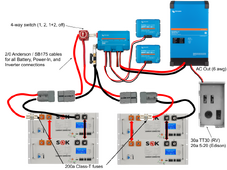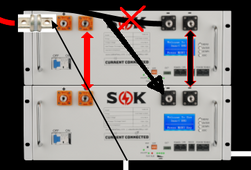mattleonard
New Member
I'm building a semi-modular off-grid/ESS system in a 5' x 8' cargo trailer for special event (not daily) use, and looking for design feedback. I was interested in the EG4 6000xp - but won't have split-phase charging ability, and getting to the minimum 120v MPPT will be challenging with the small roof footprint. While I do plan to have 2nd fold-out array, having the ability to charge with just the ~600w array on the main roof is vital, and I'm not finding panel options to get the voltage that hight. So, leaning towards a Victron system - between reliability, surge capacity, and lower MPPT voltage minimum (~5v above battery - so ~57v) it seems like the best option.
I have (2) banks of (2) 48v SOK server batteries (each pair in a rack on wheels) for modularity, as ~200lb racks are still somewhat moveable. I may add a 3rd rack in the future, and having the ability to have discrete portable/rolling 10kWh racks (with the inverter rig on top) is a great form-factor. I was thinking the SmartShunt (vs Lynx Shunt), and I'll have a Cerbo for monitoring everything.
I have (2) banks of (2) 48v SOK server batteries (each pair in a rack on wheels) for modularity, as ~200lb racks are still somewhat moveable. I may add a 3rd rack in the future, and having the ability to have discrete portable/rolling 10kWh racks (with the inverter rig on top) is a great form-factor. I was thinking the SmartShunt (vs Lynx Shunt), and I'll have a Cerbo for monitoring everything.
- Any concerns using SB175 connectors? I have made these with 2/0 in the past (though parts are harder to source). I realize with the occasional disconnecting, I'll need to make sure to due the inverter pre-charge sequence each time.
- Where to put the Class T fuse/s? Any issues mounting these directly on the battery terminals (like an MRBF terminal fuse)?
- Switch - do I need it? The idea was if only using a single a battery bank I can ensure the unplugged SB175 isn't live. But the batteries all have onboard breakers, and I can use the SB175 insulator/boots to cover them when not in use.
- Shunt - With closed-loop communication, do I even need a Shunt? If one bank is unplugged - will the Cerbo recognize the change in battery capacity, or will I need to re-program it?




